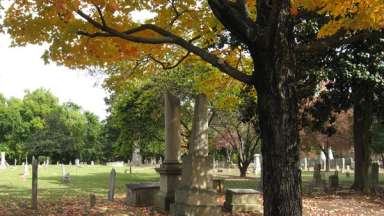Jump To:
The City of Raleigh Cemeteries staff oversees three of Raleigh's oldest cemeteries - Mt. Hope Cemetery, City Cemetery, and O'Rorke Cemetery - plus several smaller, unmarked grave site properties throughout the city. Regular interments still occur at Mt. Hope Cemetery with occasional internments at City Cemetery.
Mt. Hope Cemetery
120 Prospect Ave, Raleigh, NC 27603
In 1872, the City purchased 11.5 acres of property to provide additional public burial space for Raleigh's African-American residents. Additional burial land adjacent to the original parcel was acquired in 1895, 1912, 1914, 1926, 1945, 1947, and 1956. In 1977, the City opened Mt. Hope Cemetery to all races for burial. In 1989, the Raleigh City Council reversed its plan (dating back to 1963) to abandon the cemetery once it was filled and dropped interment prices. Records of interments, dating back to mid 1937, are maintained by the cemetery supervisor.
Historic Mount Hope Cemetery is a full-service cemetery with more than 34 acres of park-like green space surrounded by trees and the Capital Area Greenway System. Mount Hope is a beautiful and peaceful final resting place near the heart of downtown Raleigh that is open to the public during daylight hours. The cemetery has on-site staff to assist you and your family and help you achieve the memorialization you desire.
Search 1500 graves in Mt. Hope Cemetery using our web mapping application.
Audio Tour
Have you ever wandered through Raleigh’s Mt. Hope and wondered about the people buried there? Check out the audio tour to learn about the Mt. Hope Cemetery.
O'Rorke Catholic Cemetery
1101 Pender St, Raleigh, NC 27610
In 1858, John O'Rorke, a carriage shop owner, sold 1 1/8 acres of land to the Catholic Church for use as a cemetery. It is believed that burials continued until 1900. In the 1930s, Eugene McGuinness, the Bishop of Raleigh "turned over" the property to the City. (according to minutes of the Board of Commissioners, 11/25/1938). For the next, 60 years, there was considerable disagreement between the Catholic Church and the City concerning actual ownership of the property, as well as the rights and responsibilities of each party. During this period, this cemetery served as a final resting place for the city's paupers. The official Deed of Gift from Michael F. Burbidge, Bishop of the Roman Catholic Dioceses of Raleigh to the City was not signed and filed until July 10, 2009.
Work in Progress
The City renovated the turf renovations at O'Rorke Cemetery in the fall of 2009. The City also installed a black metal fence and new gates around the perimeter of the cemetery and made improvements through plantings of shrubs and perennial flowers.
Audio Tour
Have you ever wandered through Raleigh’s O'Rorke-Catholic Cemetery and wondered about the people buried there? Check out the audio tour to learn about the O'Rorke-Catholic Cemetery.
How to Clean a Stone Grave Marker
Materials Conservator, Jason Church, demonstrates how to properly clean a stone grave marker.
Video provided by the National Center for Preservation Technology and Training.
The 1990s
In September 1996, Hurricane Fran toppled a significant number of mature trees at both Mt. Hope and City Cemetery thus delaying needed repairs. An assessment of the damage was taken at both cemeteries and an archaeological study was undertaken in the summer of 1997. View the report of Hurricane Fran damage
In 1997, the State Historic Preservation Office determined that Mt. Hope Cemetery was eligible for inclusion on the National Register of Historic Places.
The 2000s
In the fall of 2006, Raleigh Parks, Recreation and Cultural Resources Department staff advertised a request for qualifications for the development of a strategic plan for the inventory and restoration of Raleigh's three historic cemeteries. The department contracted with the Chicora Foundation, Inc. from Columbia, South Carolina to work with staff and the community on the creation of this plan.
The scope of work for this project included six major components: Historical Research, Legal Research, Research of Other Projects, Research of Genealogical Inventory Practices, Site Assessments, Stakeholder Meeting and Funding Issues.
In the fall of 2007, the department reviewed and edited the draft strategic plan document produced by the consultant. Staff presented the plan and its findings to the Parks Committee of the Parks, Recreation and Greenway Advisory Board (PRGAB). Both the Committee and Board as a whole unanimously voted in favor of accepting the plan.
On September 2, 2008, the Raleigh City Council accepted the strategic plan and authorized the establishment of a stakeholder group to work collaboratively with staff in the implementation of the plan.
In January 2009, City Council approved the PRGAB's recommended nine members to serve on a stakeholder's group. The group began meeting monthly in March 2009.
In May 2009, City Council approved a name change of the stakeholder group to the City of Raleigh Historic Cemeteries Advisory Board and approved of the Board's by-laws. Sixty thousand dollars ($60,000) was reserved in the City's CIP program in FY10 for improvements to the historic cemeteries.
In October 2009, the City's cemeteries staff received a Sir Walter Raleigh Award, given to those groups or individuals who "have made outstanding contributions to the character, environment and appearance of Raleigh." The cemetery staff won in the category of Maintained Outstanding Appearance.
The 2010s
In May 2010, the Historic Cemeteries Advisory Board partnered with the Raleigh Historic Districts Commission to apply for a Historic Preservation Fund grant in the amount of $12,000 to help fund an update to the Design Guidelines for Raleigh Historic Districts.
On September 7, 2010, the Raleigh City Council designated O'Rorke-Catholic Cemetery as a Raleigh Historic Landmark.
